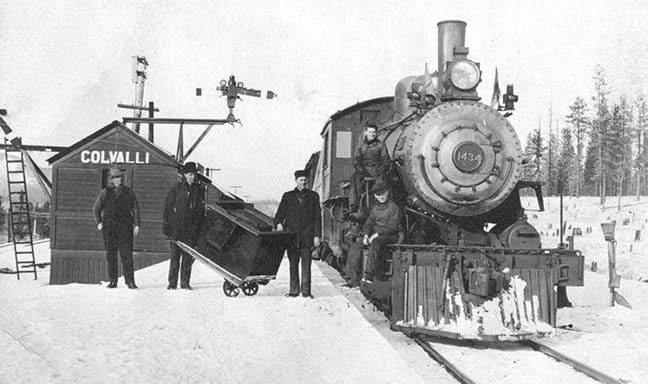Jim Cameron
It has been over a month since last we left Dr. Hugh Watt — physician and politician of Fort Steele — campaigning to have a new railway built.
It was to be called the Kootenay Central Railway and, perhaps most importantly to Dr. Watt and numerous others, the tracks would pass through Fort Steele, a town on the decline ever since the CPR bypassed it in favour of Cranbrook.
Let us recap what has happened to this point in our tale. Nothing.
(Which may cause some to wonder at the purpose of the previous article, but that is not important now. That was past history. This is 1901. Always look ahead.)
Let us look back. A petition, signed by Hugh Watt, M.D., N. Wallinger, J. Laidlaw, A.C. Nelson and 44 others of Fort Steele, arrived at the B.C. Parliament in early 1901. It was for the power to construct, equip, operate and maintain a line of railway for the carrying of freight and passengers from Elko (or a point nearby) to Fort Steele, and thence on to the town of Golden. It also included the power to expropriate lands for the purposes of the Kootenay Central Railway Company, and all other usual rights, which were many and varied. The petition was duly granted in June ,1901 (it would be extended twice more over the years), the vital first step for the fledgling company.
It was a logical plan. The CPR had the Trans-Canada line running to the north and the Crow's Nest line to the south, but nothing joining them. Coal, goods and passengers along the southern route were required to travel to Calgary and back through B.C., via Golden and Kamloops, in order to reach the west coast. Travelling to the coast from the states of Washington or Idaho, required a three day journey: a train ride to Nelson, a boat at Slocan Lake, a train to Nakusp, a boat to Arrowhead and a train to Revelstoke and beyond.
Furthermore, the construction of the KCR would open up almost 200 miles of mining, lumbering and agricultural land between the U.S. border and Golden.
What was needed was the money for construction. Enter Clement Hungerford Pollen. C. H. Pollen was a pedigreed Englishmen of considerable means. A "gentleman engineer" by trade, he was 32 years of age at the time, having come to the area in 1897, during construction of the Crow's Nest railway. He farmed at Ta-Ta Creek and later lived and maintained an office in both Cranbrook and Fort Steele at various times and, to the elation of many, took a decided interest in the KCR, replacing Dr. Watt as president of the company by 1903.
There were other investors, of course, a conglomerate from England, apparently, but the company still required some serious aid from both the Dominion (Federal) and Provincial Governments in order to undertake construction, and herein began the dance.
Nearly a decade later Mr. Pollen, upon reflection, stated, "It would have been inconsistent with western precedent had the Kootenay Central gone through its promotion in a course of easy stages. It has had its share of obstacles."
Aside from raising funds, the initial task was to undertake the surveying of the proposed route, which began in 1903. The buying and selling of real estate along the proposed line began shortly thereafter and the promises of the date of construction — well, they began in 1901, and carried on for many, many years. It was thought to commence early in 1903, in the autumn of 1904, the spring of 1905, and so on and so on and so on.
Many well-known local dignitaries lobbied the government in order to gain support. It seemed things were always looking up but nothing really ever happened. The Cranbrook City Council and Board of Trade did their best in the hopes that the southern depot of the KCR would be located in Cranbrook.
By 1909, C.H. Pollen, still president, undertook the process of selling the company to the CPR. By early 1910, with the CPR at the helm, construction began on the southern end at a point known as Colvalli (near the eastern side of the present day Koocanusa Bridge), in order to connect with the line descending from Golden to the north. The town of Canal Flats slowly emerged, the town of Fort Steele continued to die.
Finally, on December 28, 1914, after year of waiting, the Kootenay Central sent its first train into Fort Steele, too late, of course, as we know now, although, at the time, there was a great deal of jubilation in the little community. By 1915, the rail line was in regular use between Colvalli and Golden, Hugh Watt had been dead for almost a year and Clement Hungerford Pollen was a major in the 54th Battalion, fighting a war in Europe. He would eventually reach the rank of Lieutenant Colonel and die in 1934, in Surrey, England.
The CPR-KCR remained in constant use. In 1962, the CPR undertook reconstruction of the line, bringing in crushed rock from the Sullivan mine at Kimberley, in order to widen the right-of-way, thus permitting the laying of heavier rails in order to handle heavier loads. Although the former Kootenay Central Railway line remains in regular use today, the end of an era was marked in May, 1962, when the tired, old KCR passenger coach, in use for 47 years, was quietly retired in Cranbrook. Heated by a pot-bellied stove and lit by a coal oil lantern, the coach and its twin had travelled up and down the line since January, 1915, but no-one wanted to ride the train anymore.
janusthenandnow@shaw.ca
